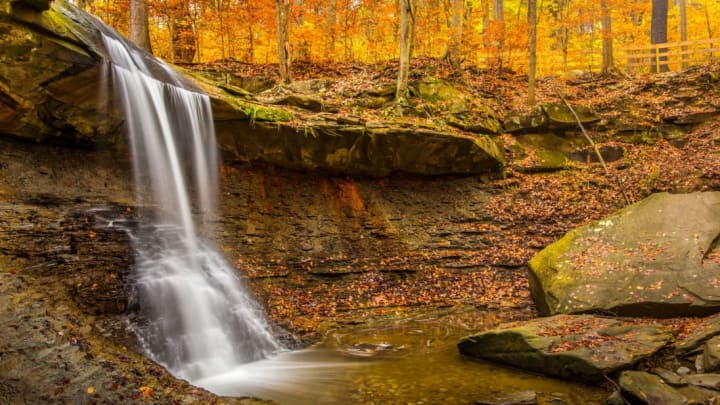Cuyahoga Valley National Park was established in Ohio in 2000 to protect and preserve the land between Akron and Cleveland. It's located on the southern shore of Lake Erie, and contains diverse amounts of flora and fauna. Though it isn’t the most well-known national park destination, it still sees more than 2 million visitors each year. Here are some interesting facts about Cuyahoga Valley National Park to know before you go.
1. Cuyahoga National Park has at least 943 different plant species.
Cuyahoga is dedicated to maintaining the region’s natural biodiversity. The vegetation is primarily in the mixed mesophytic forest category, which means there’s a medium level of moisture in the area. It’s possible to find plants like bloodroot, goldenrod, wildflowers, shrubs, and plenty more within park lines. Because some of Cuyahoga Valley National Park has been developed to include public and private businesses, many of the local forests are smaller and more dispersed than they used to be.
2. Cuyahoga was derived from a Mohawk word.
It’s generally believed the word Cuyahoga is derived from the Mohawk word Cayagaga, which means “crooked river.” This name alludes to the structure of the Cuyahoga Valley. The Cuyahoga River splits Cleveland into two sections. Both branches of the river make up a canal that stretches 80 miles throughout the state between Akron and Cleveland, where much of Cuyahoga Valley National Park is. The Seneca Nation refer to the river as Cuyohaga, which is believed to mean “place of the jawbone.”
3. Cuyahoga National Park is free to enter.

Unlike most national parks, Cuyahoga doesn't charge an entrance fee, though some park event activities may incur a cost. To help support the area, park officials recommend donating to the Conservancy for Cuyahoga Valley National Park, if you’re able to do so. The organization is dedicated to preserving, maintaining, and supporting Cuyahoga, making it an important part of the park’s infrastructure.
4. Cuyahoga became a national park in 1974.
Cuyahoga is one of the U.S.’s newer national parks. It was designated in 1974 as the Cuyahoga Valley National Recreation Area. Members of the National Park Service resisted its initial designation, as turning Cuyahoga into a national park would divert resources from many of the country's more well-known parks like Yosemite and Zion. But locals rallied to the cause, and the push to designate Cuyahoga was a success.
5. Hayward Kendall made a significant donation to Cuyahoga National Park.
Cuyahoga's value as a place for leisure goes back decades before it gained its official national park status. In 1929, accomplished businessman Hayward Kendall offered the park 430 acres of land and lasting financial support. He wanted to use the land specifically for park activities, and he championed the name “Virginia Kendall Park,” which was inspired by his mother. Today, you’ll find a lot of the park’s buildings in this particular area. It’s possible to visit a lodge, several picnic shelters, entertainment venues, camps, and even golf courses in this section of Cuyahoga.
6. Cuyahoga Valley National Park contains 32,950 acres.
Cuyahoga Valley National Park is currently one of the nation’s smaller national parks. It contains 32,950 acres of land. Comparatively, Zion National Park contains 148,016 acres; Yosemite National Park 750,000 acres; Rocky Mountain National Park 249,126 acres; and Yellowstone an astonishing 2,221,766 acres.
7. In 2020, Cuyahoga was the seventh most-visited national park.

In 2020, Cuyahoga Valley National Park saw 2,755,628 visitors, making it the seventh most-visited national park in the U.S. The six national parks that surpassed Cuyahoga’s visitation numbers are Great Smoky Mountains National Park, Yellowstone, Zion, Rocky Mountain, Grand Teton, and the Grand Canyon.
8. Cuyahoga National Park has more than 125 miles of trails.
While Cuyahoga is used for a variety of different recreational opportunities, hiking is one of the more popular activities within the park, which features over 125 miles of trails. The park doesn’t have any established campsites and it is not permitted to car camp within its boundaries, but there are a number of nearby camping options.
9. Cuyahoga National Park has become a symbol of ecosystem renewal.
Though the area was known for its air and river pollution, efforts have been in place to clean the river—an important ecological resource—since the early 1900s. As of 2021, the Cuyahoga River was removed from the lists of environmental areas of concern. It serves as a reminder that diligence and conscientious effort can help foster renewal and ecological health. Efforts to restore Cuyahoga’s natural wetlands are still in place.
10. Cuyahoga National Park is home to more than 20 reptile species.
Although most people don’t think of Ohio when they imagine a place that’s full of reptiles, Cuyahoga Valley National Park has a fair number of them. In fact, 20 different reptile species have been located within the park, including 11 different snake species, eight different turtle species, and even a skink. While no venomous snakes have been spotted within the park to date, it’s possible that the northern copperhead and the eastern massasauga may make their homes in this region.
